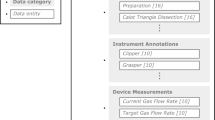Abstract
Objective
Modeling the workflow of a surgery is a topic of growing interest. Workflow models can be used to analyze statistical properties of a surgery, for intuitive visualization, evaluation and other applications. In most cases, workflow models are created manually, which is a time consuming process that might suffer from a personal bias. In this work, an approach for automatic workflow mining is presented.
Materials and methods
Ten process logs, each describing a single instance of a laparoscopic cholecystectomy, are used to build a Hidden Markov Model (HMM). Using a merging approach, models at different levels of detail are generated. These embody statistical information concerning aspects like duration of actions or tool usage during the surgery.
Results
A Graphical User Interface (GUI) is presented, that uses a graph representation of the HMM to intuitively visualize surgical workflow. It allows changing the level of detail by expanding and merging nodes. The GUI can also be used to compare videos of surgeries which are synchronized to the model.
Conclusions
The proposed method allows automatic generation and visualization of a statistical model describing the workflow of a surgery.
Similar content being viewed by others
References
van der Aalst WMP, van Dongen BF, Herbst J, Maruster L, Schimm G, Weijters AJMM (2003) Workflow mining: a survey of issues and approaches. Data Knowl Eng 47: 237–267
Maruster L, van der Aalst WMP, Weijters AJMM, van der Bosch A, Daelemans W (2002) Automated discovery of Workflow Models from hospital data. In: Proceedings of the ECAI Workshop on Knowledge Discovery and Spatial Data. pp 183–190
Jannin P, Morandi X (2007) Surgical models for computer-assisted neurosurgery. NeuroImage 37: 783–791
Neumuth T, Trantakis C, Eckhardt F, Dengl M, Meixensberger J, Burgert O (2007) Supporting the analysis of intervention courses with surgical process models on the example of 14 microsurgical lumbar discectomies. Int J Comput Assist Radiol Surg 2(Suppl 1): 436–438
Neumuth T, Schumann S, Strauß G, Jannin P, Meixensberger J, Dietz A, Lemke HU, Burgert O (2006) Visualization options for surgical workflows. Int J Comput Assist Radiol Surg 1(suppl 1): 438–440
Megali G, Sinigaglia S, Tonet O, Cavallo F, Dario P (2006) Understanding expertise in surgical gesture by means of Hidden Markov Models. International conference on biomedical robotics and biomechatronics (BioRob), Tuscany, Italy, pp 625–630
Leong JJH, Nicolaou M, Atallah L, Mylonas GP, Darzi AW, Yang GZ (2006) HMM assessment of quality of movement trajectory in laparoscopic surgery. In: Proceedings of medical image computing and computer-assisted intervention (MICCAI), Copenhagen, Denmark, pp 752–759
Rosen J, Brown JD, Chang L, Sinanan MN, Hannaford B (2006) Generalized approach for modeling minimally invasive surgery as a stochastic process using a discrete Markov model. IEEE Trans Biomed Eng 53(3): 399–413
Ohnuma K, Masamune K, Yoshimitsu K, Sadahiro T, Vain J, Fukui Y, Miyawaki F (2006) Timed-automata-based model for laparoscopic surgery and intraoperative motion recognition of a surgeon as the interface connecting the signal scenario and the real operating rool. Int J Comput Assist Radiol Surg 1(suppl 1): 442–445
Ahmadi A, Sielhorst T, Stauder R, Horn M, Feußner H, Navab N (2006) Recovery of surgical workflow without explicit models. In: Proceedings of medical image computing and computer-assisted intervention (MICCAI), Copenhagen, Denmark, pp 420–428
Padoy N, Horn M, Feußner H, Berger MO, Navab N (2007) Recovery of surgical workflow: a model-based approach. Int J Comput Assist Radiol Surg 2(suppl 1): 481–482
Rabiner LR (1989) A tutorial on Hidden Markov Models and selected applications in speech recognition. Proc IEEE 77(2): 257–286
Stolcke A, Omohundro S (1994) Inducing probabilistic grammars by Bayesian model merging. Grammatical inference and applications. In: Proceedings of the second international colloquium on grammatical inference, Alicante, Spain, pp 106–118
Stolcke A, Omohundro S (1994) Best-first model merging for hidden markov model induction. Technical report TR-94–403, ICSI, Berkeley, CA
Ellson J, Ganser E, Koutsofis L, North SC, Woodhull G (2001) GraphViz—open source graph drawing tools. Graph drawing: 9th international symposium, Vienna, Austria, pp 483–484
Herman I, Melançon G, Marshall MS (2000) Graph visualization and navigation in information visualization: a survey. IEEE Trans Visualiz Comput Graph 6(1): 24–43
Author information
Authors and Affiliations
Corresponding author
Rights and permissions
About this article
Cite this article
Blum, T., Padoy, N., Feußner, H. et al. Workflow mining for visualization and analysis of surgeries. Int J CARS 3, 379–386 (2008). https://doi.org/10.1007/s11548-008-0239-0
Received:
Accepted:
Published:
Issue Date:
DOI: https://doi.org/10.1007/s11548-008-0239-0




